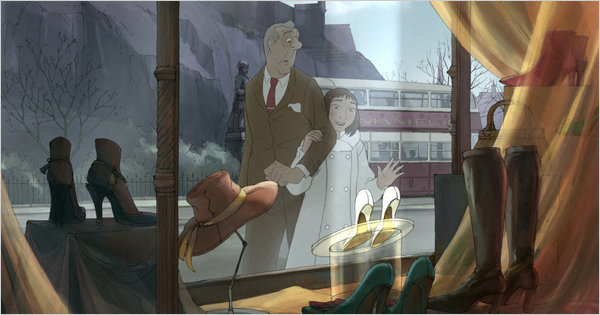Movie review by Greg Carlson
Inspired by a script written by Jacques Tati, animator Sylvain Chomet’s “The Illusionist” strolls through the wistful melancholy of a bygone era. An itinerant rabbit-and-hat performer’s act of kindness for a rural chambermaid named Alice leads to a chaste and gentle relationship that parallels the timeless tug between the outdated and the modern, the past and the future. While Chomet’s resolute commitment to missed opportunities, personal humiliations, and the crushing weight of failure distinguish “The Illusionist” from the majority of animated features, cinephiles should find much to admire in the movie’s exquisite design. More contemplative than Chomet’s “The Triplets of Belleville,” “The Illusionist” is also more rewarding.
As we follow the fragile acquaintance of the older man and the younger girl, Chomet casts his adopted country as the principal character. Few films have rendered Scotland as lovingly as “The Illusionist.” Filtered through the gauze of its late 1950s settting, Chomet’s nostalgic, romanticized Edinburgh is much closer to the leisurely picnics of “The Prime of Miss Jean Brodie” than the needle dens and filthy toilets of Danny Boyle’s “Trainspotting.” Painstakingly researched, the movie’s cityscape is a stunning simulacrum, from individual buildings to clothing styles and automobile makes and models.
Chomet constructs “The Illusionist” with remarkable restraint in an era of manic, computer-generated hallucinations populated by hyperactive, chattering beasts caroming through pinball machines built from dated movie references and shiny pop song montages. In “The Illusionist,” one is hard pressed to spot even a single facial close-up, and Chomet’s deliberate distance from the human beings has put off any number of critics quick to label the film airless, empty, and repetitive. Instead, the filmmaker mimics the wide shot staging favored by Tati predecessors Chaplin and Keaton (especially visible in a scene that alludes to the motorcar mayhem of Keaton’s 1922 “The Blacksmith” without surrendering to total chaos).
In an essay for Senses of Cinema, Tati biographer and Princeton French literature professor David Bellos complains bitterly, perhaps jealously, that Chomet has done literally “nothing” with Tati’s source material, and that the “transposition of a Tati gag from the medium of mime to the medium of animation changes its nature entirely – and makes it just a bit pointless, too.” Bellos goes on to argue that Chomet has insensibly conflated the lead character in “The Illusionist” with Tati’s signature M. Hulot persona, most probably through signifiers that include the replication of a number of Hulot gags and the film’s lack of spoken dialogue.
It must be noted, however, that the magician in “The Illusionist” shares Tati’s unaltered surname Tatischeff, not Hulot’s, and Chomet’s purpose with the character departs significantly from Tati’s careful erasure of Hulot’s “trade, profession, activity, or social integration of any sort” (as Bellos puts it). In one of the most enjoyable moments in “The Illusionist” the old conjurer hides from Alice by ducking into a screening of “Mon Oncle.” The animated figure regards his projected, live-action doppelganger with a seemingly contradictory blend of surprise and recognition, and in this single moment, Chomet reiterates his artistic prerogative to honor Tati with homage rather than mount a futile attempt at a “pure” Hulot feature.
